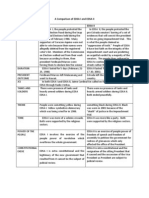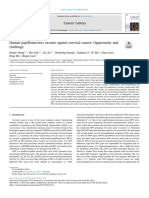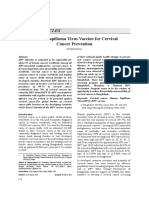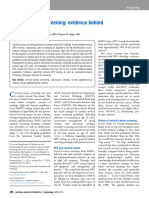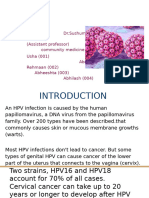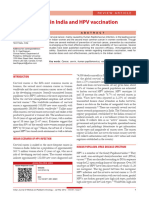Evid Based Nurs 2008 Treatment 11
Evid Based Nurs 2008 Treatment 11
Uploaded by
prakashbiotechnologist2009Copyright:
Available Formats
Evid Based Nurs 2008 Treatment 11
Evid Based Nurs 2008 Treatment 11
Uploaded by
prakashbiotechnologist2009Copyright
Available Formats
Share this document
Did you find this document useful?
Is this content inappropriate?
Copyright:
Available Formats
Evid Based Nurs 2008 Treatment 11
Evid Based Nurs 2008 Treatment 11
Uploaded by
prakashbiotechnologist2009Copyright:
Available Formats
Downloaded from ebn.bmj.com on December 4, 2010 - Published by group.bmj.
com
Review: vaccines against human
papillomavirus prevent cervical cancer
precursors in young women
BMJ Publishing Group Ltd and RCN Publishing Company Ltd
Evid Based Nurs 2008 11: 11
doi: 10.1136/ebn.11.1.11
Updated information and services can be found at:
http://ebn.bmj.com/content/11/1/11.full.html
These include:
References This article cites 2 articles
http://ebn.bmj.com/content/11/1/11.full.html#ref-list-1
Email alerting Receive free email alerts when new articles cite this article. Sign up in the
service box at the top right corner of the online article.
Topic Articles on similar topics can be found in the following collections
Collections
General practice / family medicine (20449 articles)
Immunology (including allergy) (44751 articles)
Drugs: infectious diseases (2353 articles)
Vaccination / immunisation (437 articles)
Cervical cancer (1038 articles)
Reproductive medicine (27476 articles)
Gynecological cancer (2127 articles)
Internet (1594 articles)
Notes
To request permissions go to:
http://group.bmj.com/group/rights-licensing/permissions
To order reprints go to:
http://journals.bmj.com/cgi/reprintform
To subscribe to BMJ go to:
http://journals.bmj.com/cgi/ep
Downloaded from ebn.bmj.com on December 4, 2010 - Published by group.bmj.com
Treatment
Review: vaccines against human Outcomes: high-grade cervical lesions (high-grade squamous
intraepithelial lesion or grade 2 or 3 cervical intraepithelial
papillomavirus prevent cervical cancer neoplasia [CIN]), any grade cervical lesions, persistent HPV
infection, external genital lesions, and adverse events.
precursors in young women
MAIN RESULTS
QUESTION
HPV vaccines reduced the risks of all outcomes in the
Do vaccines against human papillomavirus (HPV) prevent
modified intention-to-treat population that included 84–
cervical cancer precursors in young women?
100% of randomised women (table). Groups did not differ
for serious adverse events (table).
METHODS
Data sources: Medline and EMBASE/Excerpta Medica (to
May 2007); Medline in process (to June 2007); Cochrane CONCLUSION
Library and Cochrane Central Register of Controlled Trials Vaccines against human papillomavirus (HPV) in young
(Issue 1, 2007); conference proceedings (2004–7); clinical trial women prevent persistent infection and precancerous cervical
registers; Google Scholar; public health announcements; disease associated with vaccine-specific HPV types.
reference lists; and vaccine manufacturers.
Study selection and assessment: randomised controlled
ABSTRACTED FROM
trials (RCTs) that compared a vaccine against >1 oncogenic
Rambout L, Hopkins L, Hutton B, et al. Prophylactic
type of HPV with placebo or no HPV vaccine for prophylaxis
vaccination against human papillomavirus infection and
of oncogenic HPV-related infection and disease in women. 9
disease in women: a systematic review of randomized
reports of 6 RCTs (n = 40 323; mean age 20 y, range 15–26 y)
controlled trials. CMAJ 2007;177:469–79.
met the selection criteria. 1 RCT (n = 2392) evaluated a
monovalent HPV 16 vaccine, 2 RCTs (n = 19 757) evaluated a Correspondence to: Ms L Rambout, Ottawa Hospital, Ottawa, Ontario, Canada;
bivalent HPV 16/18 vaccine, and 3 RCTs (n = 18 174) lrambout@ottawahospital.on.ca
evaluated a quadrivalent HPV 6/11/16/18 vaccine. Quality
Source of funding: not stated.
assessment of individual trials was based on the Jadad scale
and allocation concealment; all 6 RCTs were of high c Clinical impact ratings: Family/General practice 5/7; Infectious disease 5/7;
methodological quality. Oncology 5/7; Women’s health 6/7
Vaccines against oncogenic types of human papillomavirus (HPV) v placebo or no HPV vaccine to prevent vaccine-type HPV-associated cervical cancer
precursors in young women (modified intention-to-treat population)*
Weighted event rates
Outcomes at 15–60 months Number of trials (n) Vaccine Control RRR (95% CI) NNT (CI)
Grade 2 CIN or worse 5 (36 266) 0.8% 1.5% 48% (37 to 57) 138 (116 to 179)
Any grade CIN 5 (24 613) 0.7% 1.9% 64% (55 to 71) 81 (73 to 95)
Persistent HPV infection at 6 months 3 (14 207) 0.9% 4.0% 77% (72 to 81) 33 (31 to 35)
Persistent HPV infection at 12 months 2 (7774) 0.4% 1.6% 74% (59 to 84) 86 (76 to 108)
External genital lesions 2 (5981) 1.1% 3.5% 69% (56 to 77) 41 (37 to 51)
Serious adverse events 6 (39 609) 2.2% 2.2% 0% (214 to 13) Not significant
*CIN = cervical intraepithelial neoplasia; other abbreviations defined in glossary. Weighted event rates, RRR, NNT, and CI calculated from data in article.
COMMENTARY
he systematic review by Rambout et al is a in real world populations, duration of effect, and the efficacy has not been determined. Vaccination must
T high-quality synthesis of the evidence to date
on the effectiveness of prophylactic HPV
vaccination in preventing persistent HPV infection
optimal age to immunise young women if the vaccine
is publicly funded. Despite these gaps in knowledge,
it is evident from the results of this review that
be accompanied by education on the importance of
continued routine cervical screening and safer sex
practices, regardless of immunisation status. HPV
and precancerous cervical changes in young women. prophylactic HPV vaccination can prevent type- vaccines provide a new and promising strategy for
Infection with HPV is common;1 however, current specific HPV infection and precancerous cervical primary prevention of cervical cancer that should be
primary prevention strategies, such as condom use, lesions in healthy young women (15–26 y of age) accessible to all women who can benefit from them.
can only reduce the risk of transmission.2 The who receive all 3 doses of the vaccine and have not
vaccines included in this review provide highly been previously infected with these strains. Jacqueline Muresan, RN, BScN
effective protection against 2 high-risk HPV types The conclusions of the review by Rambout et al MSc student
(16 and 18), which account for 70% of all cervical are relevant to nurses working in public health and McMaster University
Hamilton, Ontario, Canada
cancers. 1 of the vaccines tested provides additional primary health care. Education should be provided to
coverage against non-oncogenic HPV types 6 and 11, the public about HPV. Nurses can use the results of 1. National Advisory Committee on Immunization.
which have been associated with the development of this review to help parents and young women Statement on human papillomavirus vaccine. Can
external genital disease. understand the risks and benefits of immunisation Commun Dis Rep 2007;33(ACS-2):1–31.
2. Manhart LE, Koutsky LA. Do condoms prevent genital
Questions remain about the long-term effective- and make informed decisions. It is essential that
HPV infection, external genital warts, or cervical
ness of the vaccine in reducing cervical cancer clients understand that the vaccines do not protect neoplasia? A meta-analysis. Sex Transm Dis 2002;29:
incidence and mortality, effectiveness of the vaccine against all strains of HPV and that long-term vaccine 725–35.
EBN January 2008 Vol 11 No 1 11
You might also like
- 2024 Health CalendarDocument3 pages2024 Health Calendarlobomho.info88% (17)
- (Psychiatry-Theory, Applications and Treatments) Katlein França, Mohammad Jafferany - Trichotillomania (Hair Pulling Disorder)_ Clinical Characteristics, Psychological Interventions and Emotional EffeDocument126 pages(Psychiatry-Theory, Applications and Treatments) Katlein França, Mohammad Jafferany - Trichotillomania (Hair Pulling Disorder)_ Clinical Characteristics, Psychological Interventions and Emotional EffePaco La MadridNo ratings yet
- A Comparison of EDSA I and EDSA IIDocument4 pagesA Comparison of EDSA I and EDSA IIReymark B. Ibuña100% (2)
- Anatomy Physiology 10th Patton Test BankDocument7 pagesAnatomy Physiology 10th Patton Test BankfahedqNo ratings yet
- Fimmu 11 00188Document14 pagesFimmu 11 00188deasyarchikaalvaresNo ratings yet
- 1 s2.0 S0304383519306044 MainDocument15 pages1 s2.0 S0304383519306044 MainZulma madeline libny Gutarra ticaNo ratings yet
- Committee Opinion No 588 Human Papillomavirus.42Document7 pagesCommittee Opinion No 588 Human Papillomavirus.42Nicolás BertachiniNo ratings yet
- Prophylactic Efficacy of A Quadrivalent Human Papillomavirus (... )Document9 pagesProphylactic Efficacy of A Quadrivalent Human Papillomavirus (... )Micaela Ayala-PicazoNo ratings yet
- ACTN4-자궁경부암 관계 입증 논문-2Document17 pagesACTN4-자궁경부암 관계 입증 논문-2김승훈(이과대학 화학)No ratings yet
- Human Papillomavirus Vaccine Effectiveness by Age at Vaccination A Systematic ReviewDocument20 pagesHuman Papillomavirus Vaccine Effectiveness by Age at Vaccination A Systematic ReviewdeasyarchikaalvaresNo ratings yet
- NEJMra2404457Document16 pagesNEJMra2404457santibeni2107No ratings yet
- Cervical Cancer ESMODocument12 pagesCervical Cancer ESMOAndrei CorhaNo ratings yet
- Current Global Status & Impact of Human Papillomavirus Vaccination: Implications For IndiaDocument12 pagesCurrent Global Status & Impact of Human Papillomavirus Vaccination: Implications For IndiaPrasanna BabuNo ratings yet
- Keywords: Human Papillomavirus Vaccine, Efficacy, Safety, Phase III Randomized TrialsDocument10 pagesKeywords: Human Papillomavirus Vaccine, Efficacy, Safety, Phase III Randomized TrialsBassment MixshowNo ratings yet
- in_vivo-36-241Document10 pagesin_vivo-36-241dsphucnguyen3No ratings yet
- VPH NegativoDocument20 pagesVPH NegativomilequeveditoNo ratings yet
- Screening and Prevention CervixDocument82 pagesScreening and Prevention CervixKrezsa StiffensiNo ratings yet
- FIGO 2018 - Cervical CADocument15 pagesFIGO 2018 - Cervical CAJP RecioNo ratings yet
- Committee Opinion: Human Papillomavirus VaccinationDocument7 pagesCommittee Opinion: Human Papillomavirus VaccinationHugo ChavezNo ratings yet
- Viruses in Biotechnology: Dr. James MaruniakDocument48 pagesViruses in Biotechnology: Dr. James MaruniakMicrosoft TutorialNo ratings yet
- Vaccine: Contents Lists Available atDocument9 pagesVaccine: Contents Lists Available atShabrina Amalia SuciNo ratings yet
- 87 F 5Document7 pages87 F 5pangaribuansantaNo ratings yet
- 5995 FullDocument8 pages5995 FullVictor MichaelNo ratings yet
- 10 1097@aog 0000000000001708Document20 pages10 1097@aog 0000000000001708oodarkfireooNo ratings yet
- Global Dna Methylation in Human Papillomavirus Infectied Women of Reproductive Age Group An Eastern Indian StudyDocument8 pagesGlobal Dna Methylation in Human Papillomavirus Infectied Women of Reproductive Age Group An Eastern Indian StudyIJAR JOURNALNo ratings yet
- Human Papilloma Virus Vaccine For Cervical Cancer PreventionDocument9 pagesHuman Papilloma Virus Vaccine For Cervical Cancer Preventionsayeef khanNo ratings yet
- Waheed 2023 update on one dose HPVDocument9 pagesWaheed 2023 update on one dose HPVjennyjiNo ratings yet
- HPV Vaccines: Dr. Kirtan KrishnaDocument18 pagesHPV Vaccines: Dr. Kirtan KrishnaHabtamu BiazinNo ratings yet
- ADocument8 pagesArawaaNo ratings yet
- Herd Immunity: A Realistic Target?: Mini Review Open AccessDocument5 pagesHerd Immunity: A Realistic Target?: Mini Review Open AccessAshwinee KadelNo ratings yet
- Human Papillomavirus Vaccination in The European Union/European Economic Area and Globally: A Moral DilemmaDocument13 pagesHuman Papillomavirus Vaccination in The European Union/European Economic Area and Globally: A Moral DilemmaGEORGES MUTUALENo ratings yet
- Geier-Geier2017 - Article - QuadrivalentHumanPapillomaviru 2023-05-24 21 - 03 - 14Document9 pagesGeier-Geier2017 - Article - QuadrivalentHumanPapillomaviru 2023-05-24 21 - 03 - 14Stephany RodriguezNo ratings yet
- FIGO CANCER REPORT 2021 - Cancer of The Cervix Uteri 2021 Update 2021Document17 pagesFIGO CANCER REPORT 2021 - Cancer of The Cervix Uteri 2021 Update 2021amrodriguez9No ratings yet
- WHO/BS/06.2050 - Final English Only: Expert Committee On Biological StandardizationDocument66 pagesWHO/BS/06.2050 - Final English Only: Expert Committee On Biological StandardizationSleeping KnightNo ratings yet
- The Clinical Effectiveness of Single-Dose Human Papillomavirus Vaccination 2024Document26 pagesThe Clinical Effectiveness of Single-Dose Human Papillomavirus Vaccination 2024José Montero FarreraNo ratings yet
- Articulo 2 - El Microbiota Vaginal Se Asocia Con La Regresión de Neoplasia Intraepitelial CervicalDocument13 pagesArticulo 2 - El Microbiota Vaginal Se Asocia Con La Regresión de Neoplasia Intraepitelial CervicalLiliana Antonio RevueltaNo ratings yet
- Will HPV Vaccination Prevent Cervical Cancer?: Claire P Rees, Petra Brhlikova and Allyson M PollockDocument15 pagesWill HPV Vaccination Prevent Cervical Cancer?: Claire P Rees, Petra Brhlikova and Allyson M PollockGina Ionescu AnculeteNo ratings yet
- High Risk HPVDocument6 pagesHigh Risk HPVjawaralopangNo ratings yet
- Performance and Diagnostic Accuracy of A Urine-Based Human Papillomavirus Assay in A Referral PopulationDocument7 pagesPerformance and Diagnostic Accuracy of A Urine-Based Human Papillomavirus Assay in A Referral PopulationJose de PapadopoulosNo ratings yet
- Seminars in Oncology NursingDocument9 pagesSeminars in Oncology NursingangelitostorresitosNo ratings yet
- HPV Independent eDocument7 pagesHPV Independent eyoselin chirinoNo ratings yet
- 1 s2.0 S0002937815014520 MainDocument6 pages1 s2.0 S0002937815014520 Mainilham wildanNo ratings yet
- HPV Vaccine Against Anal HPV Infection and Anal Intraepithelial NeoplasiaDocument10 pagesHPV Vaccine Against Anal HPV Infection and Anal Intraepithelial NeoplasiaszarysimbaNo ratings yet
- Human Papiloma VirusDocument6 pagesHuman Papiloma VirusApotek SuryaNo ratings yet
- Efficacy of Hypnosis in The Treatment of Human Papillomavirus HPV in Women Rural and Urban SamplesDocument21 pagesEfficacy of Hypnosis in The Treatment of Human Papillomavirus HPV in Women Rural and Urban SamplesSaket RaiNo ratings yet
- Hyun Et Al. 2017 - Efficacy and Safety of TDF To Prevent MTCT of HBVDocument13 pagesHyun Et Al. 2017 - Efficacy and Safety of TDF To Prevent MTCT of HBVizvery.badNo ratings yet
- JCM 12 04142Document12 pagesJCM 12 04142Gjustina LolociNo ratings yet
- Vacunación Contra El Virus Del Papiloma HumanoDocument4 pagesVacunación Contra El Virus Del Papiloma HumanoJosé María LauricellaNo ratings yet
- Cervical Cancer, Human Papillomavirus, and VaccinationDocument2 pagesCervical Cancer, Human Papillomavirus, and VaccinationMenthosVanSelaNo ratings yet
- HPV VaccinesDocument17 pagesHPV VaccinesomarNo ratings yet
- HPV: Infection, Prevention and Vaccination in India: Ritesh KumarDocument6 pagesHPV: Infection, Prevention and Vaccination in India: Ritesh Kumarsandeep raiNo ratings yet
- Guide: DR - Sushuma. (Assistant Professor) Community Medicine Usha (001) Abdur Rehmaan (002) Abheeshta (003) AbhilashDocument27 pagesGuide: DR - Sushuma. (Assistant Professor) Community Medicine Usha (001) Abdur Rehmaan (002) Abheeshta (003) Abhilashabhilashsingha17.asNo ratings yet
- ACog-natural History of HPVDocument9 pagesACog-natural History of HPVAtit PoudelNo ratings yet
- ACOG Cervical Cancer ScreeningDocument20 pagesACOG Cervical Cancer ScreeningAlan Ahlawat SumskiNo ratings yet
- 1 PBDocument6 pages1 PBPutri Maghfirah BahriNo ratings yet
- Cervical Cancer Screening With Human Papillomavirus DNA and Cytology in JapanDocument7 pagesCervical Cancer Screening With Human Papillomavirus DNA and Cytology in Japandella kharisma putriNo ratings yet
- Cervical Intraepithelial NeoplasiaDocument16 pagesCervical Intraepithelial Neoplasiaalejandro fernandezNo ratings yet
- Ijmpo 33 7Document6 pagesIjmpo 33 7Amit PangamNo ratings yet
- EVVA Study 2017Document10 pagesEVVA Study 2017doloresNo ratings yet
- HPV Vaccines: A Controversial Issue?Document5 pagesHPV Vaccines: A Controversial Issue?RavennaNo ratings yet
- Manfaat Vaksin HPVDocument6 pagesManfaat Vaksin HPVSara AldridgeNo ratings yet
- Shin-je20GhimDocument9 pagesShin-je20Ghimdangerosgamer6807No ratings yet
- Cervical Cancer: A Comprehensive Resource for Patients and FamiliesFrom EverandCervical Cancer: A Comprehensive Resource for Patients and FamiliesNo ratings yet
- 3 Random Practicec Questions 8Document25 pages3 Random Practicec Questions 8King TasarraNo ratings yet
- MASLP Model PaperDocument13 pagesMASLP Model Paperrana binhohammedNo ratings yet
- Suggested Topic For Neet PG of All 19 Subjects..Document23 pagesSuggested Topic For Neet PG of All 19 Subjects..Vipul Khajuria100% (1)
- Green Correct Answers: Pediatrics First TakeDocument41 pagesGreen Correct Answers: Pediatrics First TakePavan chowdaryNo ratings yet
- Pram IAS Science One Liner Book For Warrior Batch-1-138-126-130-1Document1 pagePram IAS Science One Liner Book For Warrior Batch-1-138-126-130-1raj singhNo ratings yet
- Ys Eng June 2013Document68 pagesYs Eng June 2013Bheemesh GudelliNo ratings yet
- Tax Proof Submission FY 2021-22Document10 pagesTax Proof Submission FY 2021-22cutieedivyaNo ratings yet
- Children Hospital FormularyDocument236 pagesChildren Hospital Formulary1cmNo ratings yet
- PIIS1748681520303417Document6 pagesPIIS1748681520303417Lavinia CristianNo ratings yet
- Approach To Delay PubertyDocument33 pagesApproach To Delay PubertyRaja Iqbal Mulya HarahapNo ratings yet
- JurnalDocument11 pagesJurnalanindia wardhaniNo ratings yet
- Acute Neuropsychiatric Disorders in Adolecenst and Young Adults With Down Syndrome: Japanese Case ReportsDocument7 pagesAcute Neuropsychiatric Disorders in Adolecenst and Young Adults With Down Syndrome: Japanese Case ReportsPar DoNo ratings yet
- (ENG) Research Article - Pramadita Widya Garini - Imanuel Soni TanudjayaDocument10 pages(ENG) Research Article - Pramadita Widya Garini - Imanuel Soni TanudjayaImanuel SoniNo ratings yet
- Sukshma Hospi CashDocument4 pagesSukshma Hospi CashAdemuyiwa OlaniyiNo ratings yet
- Arterial Blood GasesDocument10 pagesArterial Blood GasesSoumya BhattacharyaNo ratings yet
- Topic03 Correlation RegressionDocument81 pagesTopic03 Correlation RegressionpradeepNo ratings yet
- Introduction To Toxicology 2017 by Dr. PerezDocument15 pagesIntroduction To Toxicology 2017 by Dr. PerezJohn Christopher LucesNo ratings yet
- Safari - 23-Apr-2020 at 2:19 PMDocument1 pageSafari - 23-Apr-2020 at 2:19 PMbhagwati bombNo ratings yet
- DOH ASC LTO at Checklist Otorhinolaryngologic 1262015rev1Document3 pagesDOH ASC LTO at Checklist Otorhinolaryngologic 1262015rev1al gulNo ratings yet
- Good Animal Husbandry (GAHP) For Layers and BroilersDocument23 pagesGood Animal Husbandry (GAHP) For Layers and BroilersNgan SonledaNo ratings yet
- Topic 1 Osh SituationerDocument22 pagesTopic 1 Osh SituationerIvan Dave TorrecampoNo ratings yet
- Medorog Visheshank March 2008Document8 pagesMedorog Visheshank March 2008Mitra PathakNo ratings yet
- Sas Hes032 5Document8 pagesSas Hes032 5Jose Melmar Autida AutenticoNo ratings yet
- 2.2.3. Eye Health Clinical Audit - Questions: Eye & Vision Care ToolkitDocument3 pages2.2.3. Eye Health Clinical Audit - Questions: Eye & Vision Care ToolkitCynthia Jaramillo MachucaNo ratings yet
- Tuberose CultivationDocument11 pagesTuberose CultivationKrishna Gummalla Reddy100% (1)
- Marijuana - Public Health Organizations Position On "Medical" MarijuanaDocument2 pagesMarijuana - Public Health Organizations Position On "Medical" Marijuanalearnaboutsam100% (1)


